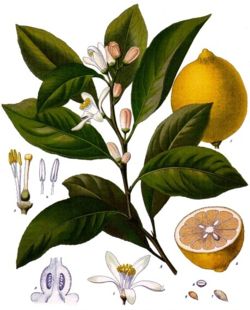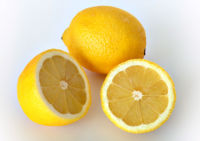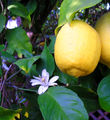Lemon
2007 Schools Wikipedia Selection. Related subjects: Food and agriculture; Plants
| iLemon | ||||||||||||||||
|---|---|---|---|---|---|---|---|---|---|---|---|---|---|---|---|---|
 Citrus x limon
|
||||||||||||||||
| Scientific classification | ||||||||||||||||
|
||||||||||||||||
|
|
||||||||||||||||
| Citrus × limon (L.) Burm.f. |
The lemon (Citrus × limon) is a hybrid citrus tree of cultivated origin. The fruit are used primarily for their juice, though the pulp and rind ( zest) are also used, primarily in cooking or mixing. Lemon juice is about 5% citric acid, which gives lemons a sour taste and a pH of 2 to 3. This acidity makes lemon juice a cheap, readily available acid for use in educational chemistry experiments.
Description
A lemon tree can grow up to 6 m (20 ft), but they are usually smaller. The branches are thorny, and form an open crown. The leaves are green, shiny and elliptical-acuminate. Flowers are white on the outside with a violet streaked interior. On a lemon tree, flowers and ripe fruits can be found at the same time. Lemon fruit are ovoid with a pointed tip at the end. When ripe they have a bright yellow skin with a paler yellow segmented interior.
There are several varieties of lemon including Eureka, Lisbon and the Meyer lemon, which is thought to be a hybrid.
Cultivation
Lemons grow in tropical and sub-tropical climates and cannot withstand frosts and very cold temperatures. Their favoured temperature is between 15–30 °C (60–85 °F) and they need ample quantities of sunlight. They thrive in fertile, well drained soils. Lemons need plenty of water but should be allowed to dry out between waterings. Propagation is often by grafting as the stock is vulnerable to cankers and dry rot.
Lemons are grown commercially in Spain, Portugal, Italy and other Mediterranean countries, Argentina, India, Brazil and the United States. They can be grown as plants in the garden as well as in containers if they are pruned to keep a small form.
History
The lemon is a cultivated hybrid deriving from wild species such as the citron and mandarin. When and where this first occurred is not known. The citron, apparently the fruit described in Pliny's Natural History (XII, vii.15) as the malum medicum — the "medicinal fruit" — seems to have been the first citrus fruit known in the Mediterranean world. Depictions of citrus trees appear in Roman mosaics of North Africa, but the first unequivocal description of the lemon, is found in the early tenth-century Arabic treatise on farming by Qustus al-Rumi. At the end of the twelfth century, Ibn Jami’, personal physician to the great Muslim leader Saladin, wrote a treatise on the lemon, after which it is mentioned with greater frequency in the Mediterranean. However, it is believed that the first lemons were originally cultivated in the hot, semi-arid Deccan Plateau in Central India.
The origin of the name "lemon" is through Persian (لیمو Limu), akin to the Sanskrit nimbuka. They were cultivated in Genoa in the mid-fifteenth century, and appeared in the Azores in 1494. More recent research has identified lemons in the ruins of Pompeii. Lemons were once used by the British Royal navy to combat scurvy, as they provided a large amount of vitamin C.
In food preparation
| Lemon, raw, without peel Nutritional value per 100 g |
||||||||||||||
|---|---|---|---|---|---|---|---|---|---|---|---|---|---|---|
| Energy 30 kcal 120 kJ | ||||||||||||||
|
||||||||||||||
| Percentages are relative to US recommendations for adults. |
||||||||||||||
Both lemons and limes are regularly served as lemonade or limeade, its equivalent, or as a garnish for drinks such as iced tea or a soft drink, with a slice either inside or on the rim of the glass. Only lemons, however, are used in the Italian liqueur Limoncello. A wedge of lemon is also often used to add flavor to water.
Lemon juice is typically squeezed onto fish dishes; the acidic juice neutralizes the taste of amines in fish by converting them to nonvolatile ammonium salts.
In addition, lemon juice is widely used, along with other ingredients, when marinating meat before cooking: the acid provided by the juice partially hydrolyzes the tough collagen fibers in the meat ( tenderize the meat). The juice, however, is not an effective antibiotic, as is commonly thought.
Lemon juice is also sprinkled on cut fruit, such as apples, to prevent oxidation which would otherwise rapidly darken the fruit, making it less appetizing. Some people like to eat lemons as fruit, however water should be consumed afterwards to wash the citric acid and sugar from the teeth, which might otherwise promote tooth decay and many other dental diseases. It can be used on its own or with oranges to make marmalade.
100 milliliters lemon juice contain approximately 50 milligrams of vitamin C and 5 grams citric acid.
There is a belief in Ayurvedic medicine that a cup of hot water with lemon juice in it tonifies and purifies the liver.
Lemon battery
A common school experiment involving lemons is to attach electrodes and use them as a battery to power a light. The electricity generated may also be used to power a motor to move the lemons (on wheels) like a car or truck. These experiments also work with other fruit like apples and with potatoes.
Lemon Alternatives
Several other Plants have a similar taste and smell to lemons. In recent times, the Australian bush food Lemon myrtle has become a popular alternative to lemons. The crushed and dried leaves and edible essential oils have a strong, sweet lemon taste, but contain no citric acid. Lemon myrtle is popular in foods that curdle with lemon juice, such as cheesecakes and ice-cream. Another, Cymbopogon or lemon grass is popular in asian cuisine to add a lemon like flavor to food. Lemon balm also has a stong lemon scent.









